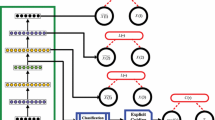Abstract
Auto-encoders have been proved to be powerful unsupervised learning methods that able to extract useful features from input data or construct deep artificial neural networks by recent studies. In such settings, the extracted features or the initialized networks only learn the data structure while contain no class information which is a disadvantage in classification tasks. In this paper, we aim to leverage the class information of input to learn a reconstructive and discriminative auto-encoder. More specifically, we introduce a supervised auto-encoder that combines the reconstruction error and the classification error to form a unified objective function while taking the noisy concatenate data and label as input. The noisy concatenate input is constructed in such a method that one third has only original data and zero labels, one third has only label and zero data, the last one third has both original data and label. We show that the representations learned by the proposed supervised auto-encoder are more discriminative and more suitable for classification tasks. Experimental results demonstrate that our model outperforms many existing learning algorithms.





Similar content being viewed by others
Explore related subjects
Discover the latest articles, news and stories from top researchers in related subjects.References
Bourlard H, Kamp Y (1988) Auto-association by multilayer perceptrons and singular value decomposition. Biol Cybern 59(4–5):291–294
Hinton GE, Zemel RS (1993) Autoencoders, minimum description length and helmholtz free energy. In: International conference on neural information processing systems, pp 3–10
Rumelhart DE, Hinton GE, Williams RJ (1986) Learning representation by backpropagating errors. Nature 323(6088):533–536
Elman JL, Zipser D (1988) Learning the hidden structure of speech. J Acoust Soc Am 83(4):1615–1626
Cottrell GW (1991) Extracting features from faces using compression networks: face, identity, emotion, and gender recognition using holons. In: Connectionist Models: Proceedings of the 1990 Summer School, pp 328–337. https://doi.org/10.1016/B978-1-4832-1448-1.50039-1
Krogh A (1992) A simple weight decay can improve generalization. Adv Neural Inf Process Syst 4:950–957
Jia K, Sun L, Gao S, Song Z, Shi BE (2015) Laplacian auto-encoders: an explicit learning of nonlinear data manifold. Neurocomputing 160:250–260
Le QV, Ngiam J, Coates A, Lahiri A, Prochnow B, Ng AY (2011) On optimization methods for deep learning In: Proceedings of the 28th International Conference on Machine Learning. Omnipress, pp 265–272
Jiang X, Zhang Y, Zhang W, Xiao X (2014) A novel sparse auto-encoder for deep unsupervised learning. In: Sixth international conference on advanced computational intelligence, pp 256–261
Liu W, Ma T, Tao D, You J (2016) Hsae: a hessian regularized sparse auto-encoders. Neurocomputing 187:59–65
Glorot X, Bordes A, Bengio Y, Deep sparse rectifier neural networks. In: Jmlr W Cp 15
Hinton G, Osindero S, Teh Y (2006) A fast learning algorithm for deep belief nets. Neural Comput 18:1527–54
Vincent P, Larochelle H, Lajoie I, Bengio Y, Manzagol PA (2010) Stacked denoising autoencoders: learning useful representations in a deep network with a local denoising criterion. J Mach Learn Res 11(6):3371–3408
Larochelle H, Erhan D, Courville A, Bergstra J, Bengio Y (2007) An empirical evaluation of deep architectures on problems with many factors of variation. In: ICML, pp 473–480
Ranzato M, Poultney C, Chopra S, Lecun Y (2006) Efficient learning of sparse representations with an energy-based model. In: Advances in neural information processing systems (NIPS 2006 1137–1144)
Vincent P, Larochelle H, Bengio Y, Manzagol PA (2008) Extracting and composing robust features with denoising autoencoders. In: Proceedings of the 25th international conference on Machine learning, pp 1096–1103
Rifai S, Vincent P, Muller X, Glorot X, Bengio Y, Contractive auto-encoders: explicit invariance during feature extraction. In: International conference on machine learning
Rifai S, Mesnil G, Vincent P, Muller X, Bengio Y, Dauphin Y, Glorot X (2011) Higher order contractive auto-encoder. Springer, Berlin
Chen FQ, Wu Y, Zhao GD, Zhang JM, Zhu M, Bai J (2014) Contractive de-noising auto-encoder. Springer, Berlin
Hosseiniasl E, Zurada JM, Nasraoui O (2016) Deep learning of part-based representation of data using sparse autoencoders with nonnegativity constraints. IEEE Trans Neural Netw Learn Syst 27(12):2486–2498
Rolfe JT, Lecun Y. Discriminative recurrent sparse auto-encoders. In: International Conference on Learning Representations (ICLR), April 2013
Razakarivony S, Jurie F (2014) Discriminative autoencoders for small targets detection. In: International conference on pattern recognition, pp 3528–3533
Lee HS, Lu YD, Hsu CC, Yu T, Wang HM, Jeng SK (2017) Discriminative autoencoders for speaker verification. In: IEEE international conference on acoustics, speech and signal processing, pp 5375–5379
Liu W, Ma T, Xie Q, Tao D, Cheng J (2017) Lmae: a large margin auto-encoders for classification. Sig Process 141:137–143
Ngiam J, Khosla A, Kim M, Nam J, Lee H, Ng AY (2011) Multimodal deep learning. In: International conference on machine learning, pp 689–696
Blake C, Merz C (1998) UCI repository of machine learning databases. Department of Information and Computer Sciences, University of California, Irvine. http://www.ics.uci.edu/~mlearn/~MLRepository.html
Huang G, Song S, Gupta JN, Wu C (2014) Semi-supervised and unsupervised extreme learning machines. IEEE Trans Cybern 44(12):1–1
Huang GB, Zhu QY, Siew CK (2006) Extreme learning machine: theory and applications. Neurocomputing 70(1–3):489–501
Acknowledgements
This work was supported by a grant from the National Key Basic Research Program of China (No.2013CB329404) and two grants from the National Natural Science Foundation of China (Nos. 61572393 and 11671317).
Author information
Authors and Affiliations
Corresponding author
Rights and permissions
About this article
Cite this article
Du, F., Zhang, J., Ji, N. et al. Discriminative Representation Learning with Supervised Auto-encoder. Neural Process Lett 49, 507–520 (2019). https://doi.org/10.1007/s11063-018-9828-2
Published:
Issue Date:
DOI: https://doi.org/10.1007/s11063-018-9828-2




